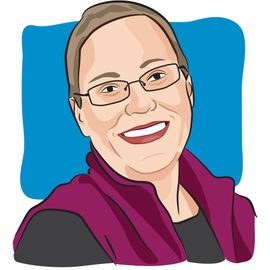- About Us
- Advertise / Support
- Editorial Board
- Contact Us
- CancerNetwork.com
- TargetedOnc.com
- OncLive.com
- OncNursingNews.com
- Terms & Conditions
- Privacy
- Do Not Sell My Information
- Washington My Health My Data
© 2025 MJH Life Sciences™ and CURE - Oncology & Cancer News for Patients & Caregivers. All rights reserved.
The Big White Cancer Binder

Martha lives in Illinois and was diagnosed with metastatic breast cancer in January 2015. She has a husband and three children, ranging in age from 12 to 18, a dog and a lizard.
Sometimes, hundreds of pages of cancer information still just doesn’t connect with the person who needs it.
Buried deep in my closet or maybe stuffed into one of several large containers full of things I don’t need any more is a big white binder (BWB). I can picture it perfectly, right down to the blank cover, blank because I removed (and crumpled up) the sheet that announced such-and-such cancer center on it in big, two-tone, block letters.
I could look for it, but I don’t.
Despite the good intentions of the teams that put together these cancer information binders, prior to landing in its long-time hiding place, my BWB just sort of languished in a stack in my bedroom. The information in it too removed from my experience as someone diagnosed at 50 with what all the statistics at the time said would probably kill me by 55.
I received the BWB during a chemotherapy prep class where even though I wasn’t “young,” I definitely stood out in the room. I gamely carried it to my first treatment, hours-long, scaryand overwhelming in the way inexplicable things tend to be. I carried it to the following week’s appointment with my oncologist, but after that I really only opened it up to find phone numbers.
Even when I tried to connect in the ways the binder suggested, it rarely worked. I was too young, I was too old, I was the wrong cancer type or the wrong stage or any number of things that kept me from the help I needed at that very moment.
I know now that there was a wealth of information out there that I just did not know how to connect to and neither, apparently, did my cancer center. The BWB, stuffed to the brim with information that didn’t reach me, reinforced my feeling at that very vulnerable point that I just did not fit in to the way cancer was supposed to be.
I often see similar disconnects and missed connections —an organization with all the best intentions and really useful information doesn’t quite get it right, the resources are there but they aren’t reaching the person who needs them. I was very involved with my kids’ schools when they were young, and I would see this there too. I realized that part of the problem is that the person needing the information and resources can’t be the one doing all the work. The school had to push information out to families. That was their job if they wanted informed and involved parents.
It’s same thing with supporting people with cancer. Make it easy. Don’t give me a website I have to search through to maybe finally get to the resource that fits my need. Direct me straight, or at least as easily as possible, to the resource.
In my opinion, this is especially important for populations that don’t fit the “standard” profile of a cancer patient. I love it when I see great ways of connecting with people who may have unique information-seeking needs or styles.
I was thinking about all of this when I was invited to the YAAS! (Young And A Survivor!) materials launch in Chicago. No, I am not their target audience of young people diagnosed with breast cancer, but I remember clearly how my cancer center’s communication style fell flat with me nearly a decade ago.
Tamara Hamlish, research assistant professor at University of Illinois Chicago’s College of Medicine, and her team took that BWB and made it immediately relevant to young women who have limited access to resources and support because of race, color, sexual orientation/identity, disability, education, income and other structural barriers. The team rethought how information reaches this population and the result is three unique packets with categories and links that are understandable and don’t require hours of deciphering.
Over the years I have been asked what it was like for me when I was diagnosed and always my first response was that I was lost and felt alone. I didn’t and don’t fit the YAAS! profile, but I know this effort will help so many young women who felt like me. You can find YAAS! On Facebook at https://www.facebook.com/youngandasurvivor/
For more news on cancer updates, research and education, don’t forget to subscribe to CURE®’s newsletters here.
Related Content:



